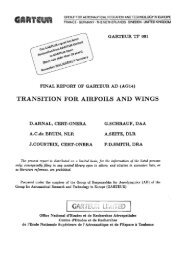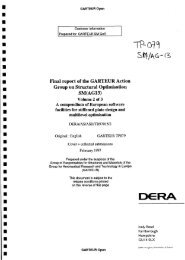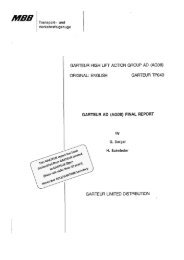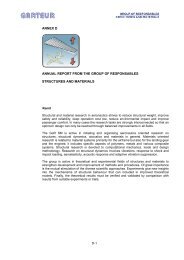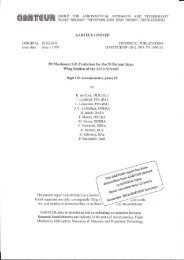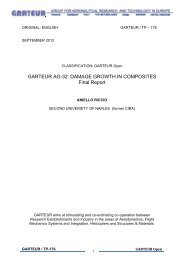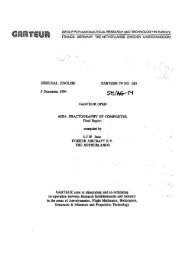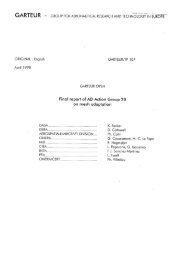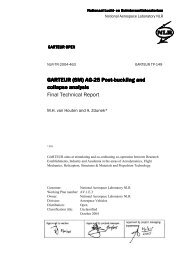Cadmium Substitution - garteur
Cadmium Substitution - garteur
Cadmium Substitution - garteur
Create successful ePaper yourself
Turn your PDF publications into a flip-book with our unique Google optimized e-Paper software.
GARTEUR LIMITED<br />
ANNEX F<br />
Stress corrosion cracking studies<br />
F.1 Introduction<br />
High strength steels are susceptible to hydrogen embrittlement and stress corrosion<br />
cracking. Conventional aqueous electrodeposition processes are less than 100%<br />
efficient and during electroplating some hydrogen may diffuse into the steel component.<br />
This may lead to failure of the component under tensile loads as a result of hydrogen<br />
embrittlement. In order to minimise the risk of failure, components are baked after<br />
plating, typically at temperatures of between 190 and 230 o C. The duration of the deembrittlement<br />
treatmen is dependent on the ultimate tensile strength of the steel. For<br />
steels with maximum tensile strengths in the range 1101 MPa to 1450 MPa the<br />
European Standard EN 2133 advises a minimum baking time of 8 hours after cadmium<br />
plating [F1]. Steels in the strength range 1451 to 1800 MPa require longer baking<br />
treatments usually at least 18 hours whilst for ultra high strength steels, i.e. above 1801<br />
MPa, times in excess of 24 hours must be employed [F2].<br />
Under certain conditions, parts manufactured from high strength steels may fail by stress<br />
corrosion cracking. For failure to occur the component must be under tensile stress and<br />
be exposed to a corrosive environment. The mechanism of stress corrosion cracking in<br />
high strength steels is normally hydrogen embrittlement. Hydrogen may be introduced<br />
into steels as a result of corrosion processes occurring on the surface of the component.<br />
A damaged coating, for example, may lead to the establishment of a galvanic corrosion<br />
cell between the coating and steel substrate. Hydrogen generated as a result of the<br />
cathodic reaction may diffuse into the steel, ultimately leading to hydrogen embrittlement<br />
failure.<br />
In the current programme both aspects of hydrogen embrittlement have been<br />
investigated.<br />
F.2 Test procedures<br />
F.2.1<br />
Hydrogen embrittlement<br />
Sustained load testing and slow bend tests were carried on a limited number of coated<br />
and heat treated samples to establish whether the recommended de-embrittlement<br />
treatments were effective [F3].<br />
Notched tensile specimens were manufactured from AISI 4340 steel heat treated to 1790<br />
- 1930 MPa. The specimens were then electroplated with zinc-nickel and subsequently<br />
de-embrittled by heat treating at 190 o C for 3 hours. Two series of 3 test pieces were<br />
placed under sustained load for 200 hours at 75% of the notched tensile strength. The<br />
tests were conducted at room temperature.<br />
A limited number of slow bend tests were conducted by Aerospatiale on a 35NCD16<br />
steel heat treated to 1800MPa. The tests were conducted in accordance with prEN 2831.<br />
The initial failure angle, α 0 , and the failure angle after surface treatment, α 1 , were<br />
measured. Details are given in reference [F4].<br />
F.2.2<br />
Stress corrosion cracking<br />
The risk of stress corrosion cracking occurring as a result of corrosion has been studied<br />
using notched tensile specimens. These were loaded to 75% of the notched tensile<br />
strength after coating, and are then subjected to alternate immersion in 3.5% sodium<br />
chloride solution until failure occurs. The performance of each of the coatings has been<br />
GARTEUR SM/AG17 TP128 Page 85




